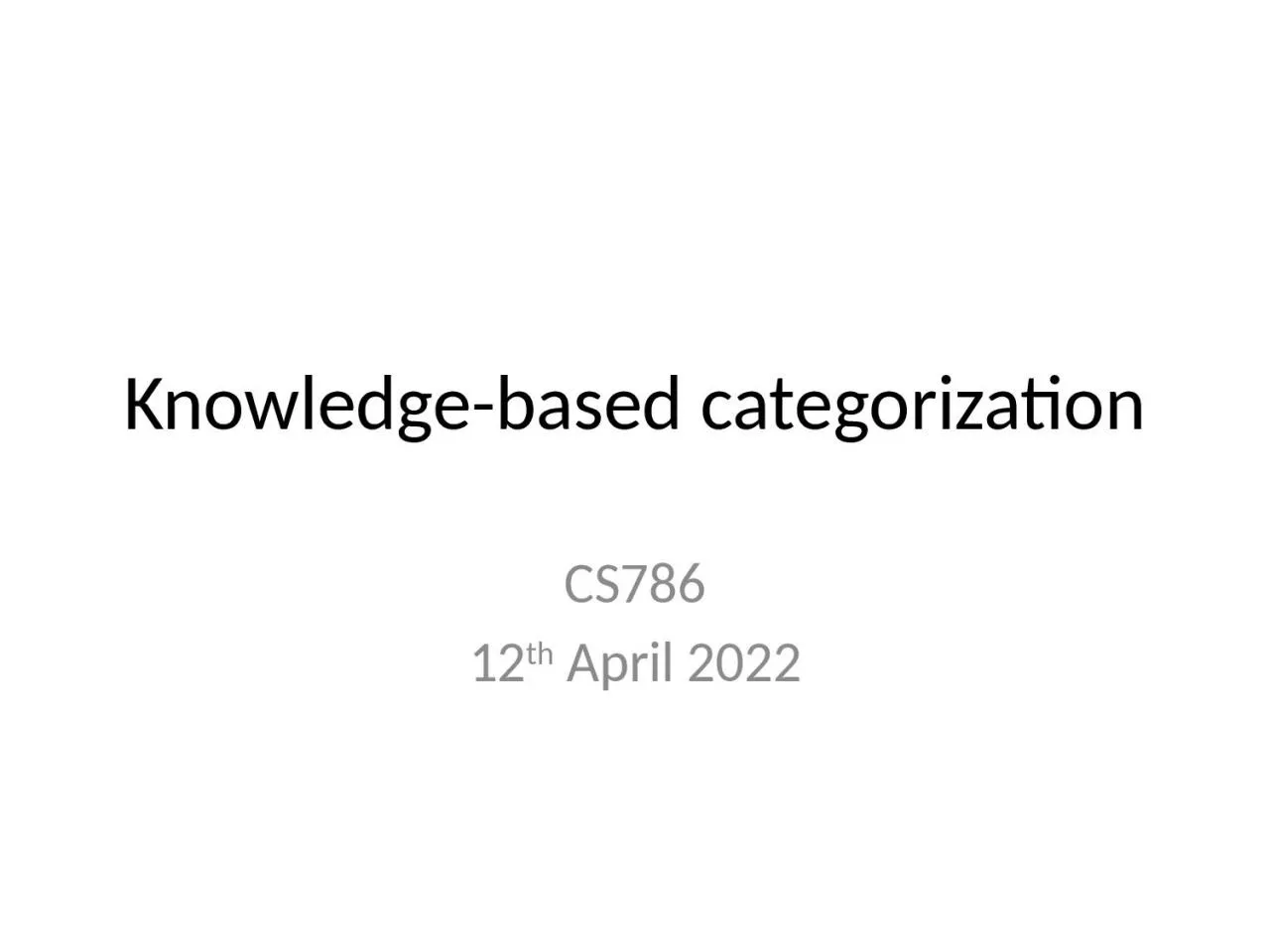

CS786 12 th April 2022 Knowledgebased Views Murphy 2002 p 183 Neither prototype nor exemplar models have attempted to account for knowledge effects The problem is that these models start from a kind of ID: 1021110
Download Presentation The PPT/PDF document "Knowledge-based categorization" is the property of its rightful owner. Permission is granted to download and print the materials on this web site for personal, non-commercial use only, and to display it on your personal computer provided you do not modify the materials and that you retain all copyright notices contained in the materials. By downloading content from our website, you accept the terms of this agreement.
1. Knowledge-based categorizationCS78612th April 2022
2. Knowledge-based ViewsMurphy (2002, p. 183):“Neither prototype nor exemplar models have attempted to account for knowledge effects . . . The problem is that these models start from a kind of tabula rasa [blank slate] representation, and concept representations are built up solely by experience with exemplars.”
3. Effect of Knowledge on Concept LearningConcept learning experiment involving two categories of children’s drawingsTwo learning conditions:neutral labels for categories (Group 1 vs. Group 2 children)Category labels induced use of background knowledge: “Creative and non-creative children created category A and B drawings respectively”Note: same stimuli are used in both conditions Palmeri & Blalock (2000)
4. Palmeri & Blalock (2000)By manipulating the meaningfulness of the labels applied to those categories of drawings, subjects classified new drawings in markedly different ways. E.g., neutral labels led to an emphasis of concrete features. The “creative vs. non-creative” labels led to an emphasis of abstract featuresBackground knowledge and empirical information about instances closely interact during category learning
5. Learning an exemplar model from labelsOriginal GCM model had no learningParameters fit to data Basically just a clustering model (unsupervised)Later models offer learning mechanismsKruschke’s ALCOVE model (1992)Assumes a supervised learning setting Learner predicts categoriesTeacher teaches true category
6. Supervised learning in ALCOVEActivation of category k given stimulus yTraining loss functionWhere t is a training label that is 1 if the predicted response is correct and 0 otherwise
7. Optimization using gradient descentAll weights and parameters are learned using gradient descentWeight updateExemplar-wise errorAttention update
8. VariationsGCM-class models assume the presence of interval-scaled psychological distancesCan make different assumptions about similarity function, e.g. categorical instead of continuous scale# of matches# of mismatches# matches - # mismatchesCan make different assumptions about the learning mechanismAnderson’s Rational Model of CategorizationWe will see this next
9. Categories of categorization modelsPrototype models assume people store singular prototypesNew stimuli are categorized based on distance from psychological distance from prototypeExemplar models assume people store many examplesNew stimuli are categorized based on average distance from these exemplarsPrototypeExemplars
10. What do people do?Let’s look at an experiment by Smith & Minda (1998)Stimuli were 6 digit binary stringsCategory A000000, 100000, 010000, 001000, 000100, 000001, 111101Category B111111, 011111, 101111, 110111, 111011, 111101, 111110, 000100All 14 stimuli presented, randomly permuted, 40 timesPeople asked to categorize into A and B, with feedback
11. What would a prototype model do?P(category A)Can’t get the oddball category members right
12. What would an exemplar model do?p(category A)Doesn’t learn across segments, because exemplars don’t change
13. What do people actually do?p(category A)Start off as prototype models, but then self-correct
14. ProblemsCan’t explain complex categorizationAcross linearly separable boundariesCan’t capture effect of category varianceCan’t capture learning curves in categorizationCan’t explain complex categorizationAcross linearly separable boundariesWithout a lot of ad hoc assumptions
15. RealityPeople behave as if they are storing prototypes sometimesCategory judgments evolve over multiple presentationsSensible thing to do in situations where the category is not competing with others for membershipPeople behave as if they are storing exemplars sometimesProbability matching behavior in describing category membershipSensible thing to do when discriminability at category boundaries becomes importantShouldn’t we have models that can do both?
16. A Bayesian observer model of categorizationWant to predict category label c of the Nth object, given All objects seen before andTheir category labelsSequential Bayesian updateAssumption: only category labels influence the prior. Can you think of situations when this would be broken?
17. Connection with classic modelsRemember the GCM category response calculation?Look at the numerator of the Bayesian modelLikelihoodPriorPriorLikelihoodLet’s call this likelihood LN,j
18. A unifying viewIn an exemplar modelIn a prototype modelCrucial insightPrototype model is a clustering model with one clusterExemplar model is a clustering model with N clustershttps://hekyll.services.adelaide.edu.au/dspace/bitstream/2440/46850/1/hdl_46850.pdf